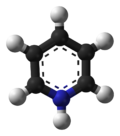This is an old revision of this page, as edited by Beetstra (talk | contribs) at 15:14, 10 August 2011 (Script assisted update of identifiers for the Chem/Drugbox validation project (updated: 'StdInChIKey').). The present address (URL) is a permanent link to this revision, which may differ significantly from the current revision.
Revision as of 15:14, 10 August 2011 by Beetstra (talk | contribs) (Script assisted update of identifiers for the Chem/Drugbox validation project (updated: 'StdInChIKey').)(diff) ← Previous revision | Latest revision (diff) | Newer revision → (diff)| This article does not cite any sources. Please help improve this article by adding citations to reliable sources. Unsourced material may be challenged and removed. Find sources: "Pyridinium" – news · newspapers · books · scholar · JSTOR (December 2009) (Learn how and when to remove this message) |
| |||
| Names | |||
|---|---|---|---|
| IUPAC name pyridinium | |||
| Identifiers | |||
| CAS Number | |||
| 3D model (JSmol) | |||
| ChemSpider | |||
| PubChem CID | |||
| CompTox Dashboard (EPA) | |||
InChI
| |||
SMILES
| |||
| Properties | |||
| Chemical formula | C5H6N | ||
| Molar mass | 80.110 g·mol | ||
| Except where otherwise noted, data are given for materials in their standard state (at 25 °C , 100 kPa).
| |||
Pyridinium refers to the cationic form of pyridine. This can either be due to protonation of the ring nitrogen or because of addition of a substituent to the ring nitrogen, typically via alkylation. The lone pair of electrons on the nitrogen atom of pyridine is not delocalized, and thus pyridine can be protonated easily. Pyridine is often used as an organic base in chemical reactions, thus the pyridinium ion is produced as the counter ion to the leaving group in the reaction. This complex is often insoluble in the organic solvent, so precipitation of the pyridinium leaving group complex is an indication of the progress of the reaction. The pyridinium ion also plays a role in Friedel-Crafts acylation. When pyridine is included, it forms a complex with the electrophillic acylium ion, rendering it even more reactive.
See also
This article about an organic compound is a stub. You can help Misplaced Pages by expanding it. |

